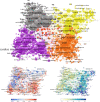The evolution of digital health technologies in cardiovascular disease research
- PMID: 36596833
- PMCID: PMC9808768
- DOI: 10.1038/s41746-022-00734-2
The evolution of digital health technologies in cardiovascular disease research
Abstract
When implemented in practice, digital technologies have shown improvements in morbidity and mortality outcomes in patients with cardiovascular disease (CVD). For scholars, research into digital technologies in cardiovascular care has been relatively recent, thus it is important to understand the history of digital health technology in cardiovascular research-its emergence, rate of growth, hot topics, and its temporal evolution. The aim of this study was to analyse more than 16,000 articles in this domain based on their scientometric indicators. Web of Science (WoS) Core Collection was accessed and searched at several levels, including titles, abstracts, keywords, authors, sources and individual articles. Analysis examined the temporal shifts in research and scholarly focus based on keywords, networks of collaboration, topical divisions in relation to digital technologies, and influential publications. Findings showed this research area is growing exponentially. Co-citation analysis revealed twenty prominent research streams and identified variation in the magnitude of activities in each stream. A recent emergence of research activities in digital technology in cardiovascular rehabilitation (CR), out-of-hospital cardiac arrest (OHCA), and arrythmia research was also demonstrated. Conversely, wearable technologies, activity tracking and electronic medical records research are now past their peak of reported research activity. With increasing amounts of novel technologies becoming available and more patients taking part in remote health care monitoring, further evaluation and research into digital technologies, including their long-term effectiveness, is needed. Furthermore, emerging technologies, which are evaluated and/or validated should be considered for implementation into clinical practice as treatment and prevention modalities for CVD.
© 2023. The Author(s).
Conflict of interest statement
The authors declare no competing financial interests but the following Competing Non-Financial Interests: Author Julie Redfern is an Associate Editor of npj Digital Medicine but played no role in the assessment or peer review of this manuscript.
Figures






References
-
- Health AIo, Welfare. Digital health. Canberra: AIHW; 2020.
-
- Darkins A, Darkins AW, Cary MA, Cary M. Telemedicine and telehealth: principles, policies, performances and pitfalls: Springer publishing company; 2000.
-
- World Health Organization. Universal Health Coverage Geneva: World Health Organization; 2022 [Available from: https://www.who.int/health-topics/universal-health-coverage#tab=tab_3.
-
- Georgeff M. Patients and technology: Digital technologies and chronic disease management. Aust. Fam. physician. 2014;43:842–846. - PubMed
Publication types
LinkOut - more resources
Full Text Sources
Miscellaneous

